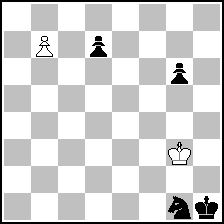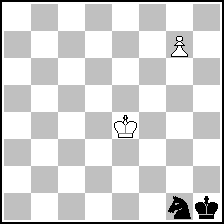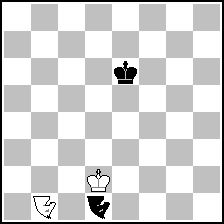
Website founded by
Milan Velimirović
in 2006
0:09 UTC


| |
MatPlus.Net  Forum Forum  General General  chameleon-hopper chameleon-hopper |
| |
|
|
|
|
You can only view this page!
| | Page: [Previous] [Next] 1 2 | | (1) Posted by Dan Meinking [Tuesday, Sep 27, 2011 10:50] | chameleon-hopper
Having recently worked with chameleons for the first time, I wondered if the concept has ever been applied to hoppers.
chameleon-hopper: A piece which transforms in the sequence NH=>BH=>RH=>G=>NH.
Here's a simple example:
 (= 2+4 ) (= 2+4 )
ser-#5 (2+4) C? {chameleon-hopper Pb7}
1.b8=NH 2.NHh5=BH 3.BHf7=RH 4.RHc7=G 5.Ge7=NH#
Anything new?
| | | (2) Posted by Dan Meinking [Tuesday, Sep 27, 2011 11:18]; edited by Dan Meinking [11-09-27] |
Here's a nicer (Wenigsteiner) version of the above problem, with an interesting twin:
 (= 2+2 ) (= 2+2 )
ser-#9 b) wKe6 (2+2) C? {chameleon-hopper g7}
a) 1.g8=NH 2.NHd2=BH 3.Kf4 4.BHg5=RH 5.Ke5 6.RHd5=G 7.Gf5=NH 8.Kf4 9.Kg3#
b) 1.g8=BH 2.Bhd5=RH 3.Kd6! 4.RHd7=G 5.Ke6 6.Gf5=NH 7.Ke5 8.Kf4 9.Kg3#
Too bad the last two moves are duplicated.
| | | (3) Posted by Kevin Begley [Tuesday, Sep 27, 2011 20:20]; edited by Kevin Begley [11-09-27] |
>chameleon-hopper: A piece which transforms in the sequence NH=>BH=>RH=>G=>NH.
Good idea... might even be original.
There is a minor glitch in your first example: 2.CNHb8-h5?? is an illegal move.
A Nightrider-Hopper, or Chameleon-NH, can move only to f6 here.
Unless you intended this to be a chameleon-contra-hopper...?
btw: Chameleons are not only individual fairy pieces, there is also the option to employ the condition, "Chameleon Chess."
The point being, rather than defining an additional fairy element (the chameleon-hopper promoting pawn) -- which is an unusual measure to prevent the orthodox solution (1.b8Q 2.Qb2 3.Qg2/Qh2#) --, you might instead consider defining a condition (which would apply to all promotions).
However, in this case, the orthodox Knight (g1) may create secondary promotion issues.
Using Win Chloe, I defined your pieces (only takes a minute), and tested your second problem...
Some corrections are required:
Part b) in the second example cooks in 8:
1.g8=CBH 2.CBHd5(=CRH) 3.Kf5 4.Kg5 5.CRHh5(=CGH) 6.CGHf5(=CNH) 7.Kh4 8.Kg3#
Part a) is C+, after the promotion:
1.g8=CNH 2.CNHd2(=CBH) 3.Kf4 4.CBHg5(=CRH) 5.Ke5 6.CRHd5(=CGH) 7.CGHf5(=CNH) 8.Kf4 9.Kg3#
However, this too is cooked (prior to the promotion)...
1.g8=CRH 2.Kf5 3.Kg6 4.CRHg5(=CGH) 5.Kf6 6.CGHe7(=CNH) 7.Kg5 8.Kh4 9.Kg3#
Anyway, nice idea -- hope you can correct/improve your examples...
| | | (4) Posted by Dan Meinking [Tuesday, Sep 27, 2011 21:50] |
@Kev -- Welcome back. :-)
Thanks for testing the examples. The first one we can safely toss. The second one, we can toss part b) since there's too much duplication anyways. I believe part a) can be fixed by Gg1 or RHg1.
Oddly enough, the subject of "Chameleon Chess" came up very recently. Apparently there are differences in how Popeye and WC treat the 'presence of a chameleon pawn'. I cannot disclose more than that. A blanket 'chameleon' condition could be applied in certain cases, but there may be situations where the composer will only want specific Pawns to have those priveleges.
The 'chameleon-hopper' idea could be extended to other logical groups:
- Moose, Eagle, Sparrow
- Chinese Pieces
- Marine Pieces
- Contra Hoppers (per your suggestion)
- 1/3-leaper, 2/4-leaper, 3/5-leaper
- etc.
In fact, individual Pawns could be earmarked for promotion-groups. For example: a 'hopper-Pawn' could promote to NH, BH, RH or G without the 'chameleon' constraint. I wouldn't be surprised if there was already a condition for this.
| | | (5) Posted by Joost de Heer [Tuesday, Sep 27, 2011 22:44] |
Popeye knows chameleon-chinese pieces: 'condition leofamily chameleonchess'.
| | | (6) Posted by seetharaman kalyan [Wednesday, Sep 28, 2011 00:07] |
Are hoppers chinese pieces? Chinese pieces typically move and capture differently.
| | | (7) Posted by Kevin Begley [Wednesday, Sep 28, 2011 02:33]; edited by Kevin Begley [11-09-28] |
re: correction to part b)
It was sound w/ bSg1, but if you replace bS with bCG (or bG), a second solution creeps in:
1.g8=CNH 2.CNHd2(=CBH) 3.Kf4 4.CBHg5(=CRH) 5.Ke5 6.CRHd5(=CGH) 7.CGHf5(=CNH) 8.Kf4 9.Kg3#
1.g8=CNH 2.CNHd2(=CBH) 3.Ke3 4.CBHf4(=CRH) 5.Kf3 6.CRHf2(=CGH) 7.Kf4 8.CGHf5(=CNH) 9.Kg3#
| | | (8) Posted by Dan Meinking [Wednesday, Sep 28, 2011 03:49] |
@Joost: I tried ChameleonChess in a simple position, but it didn't seem to impact the promotion possibilities. Also tried a piece rather than pawn, still no impact. Maybe this condition means something other that what I had in mind.
@Seetharaman: You are correct. My point was that different groups (not necessarily hoppers) could be defined in the same manner.
@Kevin: Ahh, I should've seen that. Surely this K+P setting must be sound:
 (= 2+2 ) (= 2+2 )
ser-#8 (2+2) C? {chameleon-hopper Pe7}
1.e8=BH 2.BHb5=RH 3.Kc5 4.RHd5=G 5.Kd4 6.Gd3=NH 7.Ke3 8.Kf2#
| | | (9) Posted by Kevin Begley [Wednesday, Sep 28, 2011 04:11]; edited by Kevin Begley [11-09-28] |
@Dan,
Yes, your last is C+.
Here's an echo I fleshed out with win chloe's help (unfortunately, a few minor move repetitions @ b5 & b7):
KB
 (= 2+2 ) (= 2+2 )
h#7 __ 0.2.1... __ (2+2) C+
  Chameleon-Grasshoppers Chameleon-Grasshoppers
1…Kc2 2.CGHc1(=CNH) Kd3 3.CNHe5(=CBH) Kc3 4.CBHb2(=CRH) Kd4 5.Kg2 CGHd3(=CNH) 6.CRHh2(=CGH) Ke3 7.Kh1 Kf2#
1…Ke2 2.CGHf1(=CNH) Kf3 3.CNHc7(=CBH) Kf4 4.CBHg3(=CRH) Ke5 5.Kg2 CGHf5(=CNH) 6.CRHg1(=CGH) Kf4 7.Kh1 Kg3#
An important lesson for our FIDE judges: distant echoes, which achieve nothing more than distant echoes, are usually a trivial computer discovery.
This is especially true in problems tainted by elongating and/or constraining conditions (FML, mini, maxi, koko, etc).
Multiple elements are only warranted if all are specific to the central idea -- just imagine a fairy tale, where the magical elements serve no central purpose in the story.
A good judge would account, first & foremost, for any supplementary thematic analogies (/tasks) which are demonstrated (in echo form).
Then -- in the full context of the author's thematic motivation -- the judge would evaluate any weaknesses (such as the repeated moves, seen above), including infringements upon the overall economy of the work.
I believe the correct hierarchical order of importance (weighted costs for materials used) runs as follows:
1) the specific economy of fairy elements employed should be considered of primary importance,
2) followed by the economy of moves (brevity should always be preferred), and
3) finally, economy of units (and the freedom in their distribution) should be weighted.
I am sorry for going off topic here... I swore I would never again get involved in controversial discussions in this forum.
But, the above provides an opportunity I just can't pass on...
Somebody needs to tell the Antiquated Bohemian School that it's high time they updated their (still pre-fairy era) evaluation check list.
For anybody keeping score: none of this has anything to do with Dan (or this very interesting fairy idea of his)... just something I had to get this out of my system...
And, having said my peace, I look forward to more Chameleon-Hopper examples. :)
| | | (10) Posted by Dan Meinking [Wednesday, Sep 28, 2011 08:46] |
Nice echoes! I don't think the repetition is so bad. It's certainly a challenging solve, even though the finales are 'obvious'.
| | | (11) Posted by Kevin Begley [Wednesday, Sep 28, 2011 12:31]; edited by Kevin Begley [11-09-28] |
Thanks... it is nice that both solutions show black's chameleon passing through all phases, and back to grasshopper.
But, I have not exhaustively searched -- I have reason to suspect better echoes might be possible (especially in separate corners).
Oh, and it was enormous fun just inventing crazy ways to retract these mad-hopping-chameleons! :)
| | | (12) Posted by Kevin Begley [Wednesday, Sep 28, 2011 14:29]; edited by Kevin Begley [11-09-28] |
ps:
I am intrigued as to what differences popeye/WChloe exhibit in the 'presence of a chameleon pawn.'
I don't find an explicitly defined "Pion Cameleon" in WChloe (though, I could certainly work more on my French).
There are, of course, a variety of ways one might realize such a unit: apply the "Caméléon" condition, or define all chameleon units and then apply the "Promotions uniquement en pièce féerique" condition, or apply the pre-defined "Caméléon-Pion" promotion scheme, or define your own scheme...
Nor is there an explicitly defined "ChameleonPawn" in popeye, but again, there are a few ways one might realize such a unit: apply the "ChameleonChess" condition, or simply instantiate such a unit (e.g., "pieces white chameleon Pg7")...
So far, I haven't managed to uncover any serious differences... but, this may well depend upon selecting a non-analogous realization scheme.
On the other hand, it is entirely possible that somebody may be misreading how "Caméléon Pion-Cavalier (Pion)" (for example) functions in WChloe.
There are a few Chameleon-Pawns pre-defined by WChloe, but they are in no way analogous to the popeye instantiation.
These constitute an alternative chameleon metamorphosis cycle, which has been pre-defined (perhaps due to its popularity).
For example, a "Caméléon Pion-Cavalier (Pion)" behaves as a pawn, but upon moving toggles into a "Caméléon Pion-Cavalier (Cavalier)," which, upon moving (as a Knight), would immediately toggle back.
Same goes for "Caméléon D-P-C-F-T (pion)," except that now the unit must undergo a 5-stage metamorphosis cycle (QRB added in) before it can toggle back to pawn behavior.
[note: I avoid saying "pawn-state" because chameleons appear to be defined as unique units for Madrasi/Isardam purposes.]
The promotion/e.p./castling implications of chameleons are specific to their fairy definition (and, as such, these pawns may not be analogous to an orthodox pawn w/ exclusively chameleon promotion options).
| | | (13) Posted by Kevin Begley [Wednesday, Sep 28, 2011 16:49]; edited by Kevin Begley [11-09-28] |
Hmm, something's funny!
Why not 1. ...Kc2 2.CGc1(=CNH) Kb3 3.CNHa5(=CBH) Kc3 4.CBHd2(=CRH) Kd4 5.Kg2 CGd3(=CNH) 6.CRHh2(=CG) Ke3 7.Kh1 Kf2#
Looks like a cook -- either I am missing something here, or I must have made some mistake when defining these units!
D'oh, nevermind -- missed the self-check: 5...CGd3(=CNH)??
| | | (14) Posted by Joost de Heer [Wednesday, Sep 28, 2011 18:53] |
My version of Popeye (CVS version) recognises chameleon-chinese pieces:
[joost@linux ~]$ py
Popeye Linux-2.6.40.3-0.fc15.x86_64-x86_64-64Bit v4.58 (1024 MB)
begin
pie whi pc7
stip ser-zh32
cond chameleonchess leofam
end
+---a---b---c---d---e---f---g---h---+
| |
8 . . . . . . . . 8
| |
7 . . P . . . . . 7
| |
6 . . . . . . . . 6
| |
5 . . . . . . . . 5
| |
4 . . . . . . . . 4
| |
3 . . . . . . . . 3
| |
2 . . . . . . . . 2
| |
1 . . . . . . . . 1
| |
+---a---b---c---d---e---f---g---h---+
ser-zh32 1 + 0
Leofamily
ChameleonChess
1.c7-c8=LE 2.LEc8-h3=MA z
1.c7-c8=VA 2.VAc8-h3=PA z
| | | (15) Posted by Dan Meinking [Wednesday, Sep 28, 2011 19:38] |
@Kevin: I emailed you re: the 'presence of a cP' issue.
@Juraj: OK, I get it now. ChameleonChess applies to any piece on-board. Pawns promote to normal S/B/R/Q rather than cS/cB/cR/cQ, then transform S->B->R->Q->S each move thereafter.
| | | (16) Posted by Geoff Foster [Thursday, Sep 29, 2011 03:13] |
In WinChloe the chameleon pawn is "Pion-Cameleon" (note the "-" character). In Popeye it is defined just like any other chameleon piece e.g. a white chameleon pawn on d5 would be "white chameleon pd5".
| | | (17) Posted by Kevin Begley [Thursday, Sep 29, 2011 05:23]; edited by Kevin Begley [11-09-29] |
@Geoff,
I believe I have resolved the popeye/WChloe chameleon-pawn issue -- check with Dan (the problem was not properly defined to Win Chloe)...
And, popeye (which really aches for a glossary of fairy units) has a minor bug.
I'll leave it in your capable hands to disclose this issue (at the proper time & venue). :)
Revision: I'm probably wrong to have labeled this a popeye bug.
It seems this may turn out to be an unanticipated use of the tool (to declare a "chameleon unit" w/o defining that unit as a member of the chameleon metamorphosis cycle).
It remains to be seen whether this was the intended purpose... and whether the developers intend to continue supporting this feature.
| | | (18) Posted by Kevin Begley [Thursday, Sep 29, 2011 15:08]; edited by Kevin Begley [11-09-29] |
@Dan,
Eureka! Chameleon-Echoes via Chameleon-Hoppers (ideal, exact, in 2 corners):
KB
 (= 2+2 ) (= 2+2 )
h#8 __ 2.1... __ (2+2) C+
  = Chameleon-Nightrider-Hoppers = Chameleon-Nightrider-Hoppers
1.Kf5 Kc3 2.CNHg7(=CBH) CNHd5(=CBH) 3.Ke4 CBHf3(=CRH) 4.CBHb2(=CRH) CRHb3(=CG) 5.Kf3 CGd3(=CNH) 6.Kg2 Kd4 7.CRHh2(=CG) Ke3 8.Kh1 Kf2#
1.Kd5 Ke3 2.Kc4 Ke4 3.Kc3 CNHd5(=CBH) 4.CNHb5(=CBH) CBHf3(=CRH) 5.Kb2 Kd3 6.CBHe2(=CRH) CRHc3(=CG) 7.CRHa2(=CG) CGe3(=CNH) 8.Ka1 Kc2#
| | | (19) Posted by Dan Meinking [Thursday, Sep 29, 2011 17:36] |
Wow, what a gem! There's hope for the chameleon-hopper yet. :-)
| | | (20) Posted by Ian Shanahan [Friday, Sep 30, 2011 19:08]; edited by Ian Shanahan [11-09-30] |
This thread suggests to me another new piece - a QUERQUISITE-HOPPER. (A querquisite moves like the piece upon whose game-array file it lies). So a Q-H would be a grasshopper, rookhopper, bishopper or nightriderhopper, depending on which file it sits. In the case of the kings' file the Q-H would hop to squares (0,2) or (2,2) away over a hurdle at (0,1) or (1,1) ... as a kind of limited G and contra-G.
As above, this concept could be generalised to create querquisite-locusts, -marines, etc.
| |
Read more... | Page: [Previous] [Next] 1 2
MatPlus.Net  Forum Forum  General General  chameleon-hopper chameleon-hopper |
|
|
|
 ISC 2024
ISC 2024 Forum
Forum  General
General  chameleon-hopper
chameleon-hopper 


